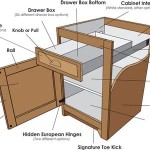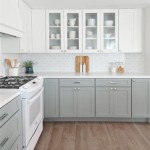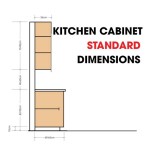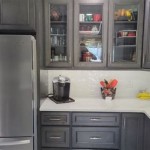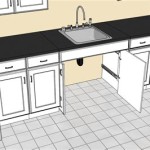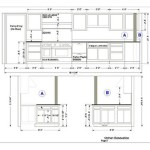Can You Refinish Cabinets? A Comprehensive Guide to Cabinet Refinishing
Cabinets are a fundamental element of any kitchen or bathroom, significantly impacting the overall aesthetic and functionality of the space. Over time, cabinets can become worn, outdated, or simply no longer align with evolving design preferences. Instead of opting for a complete cabinet replacement, which can be a costly and disruptive undertaking, refinishing presents a viable and often more economical alternative. Refinishing cabinets involves refreshing the existing cabinet surfaces, offering a refreshed look without the extensive demolition and installation associated with replacement. This article provides a comprehensive overview of cabinet refinishing, including the process, considerations, and potential benefits.
Understanding the Scope of Cabinet Refinishing
Cabinet refinishing is a process that focuses on updating the exterior appearance of existing cabinets. It typically involves preparing the cabinet surfaces, applying a new finish, and updating hardware. This process typically does not involve altering the cabinet's structure or layout. The core of refinishing lies in stripping away old finishes, sanding the surfaces smooth, and applying new paint, stain, or other coatings to rejuvenate the cabinets. In essence, refinishing offers a cost-effective way to revamp the look and feel of a kitchen or bathroom without a complete overhaul.
The success of cabinet refinishing hinges on the initial condition of the cabinets. If the cabinets are structurally sound, with no significant damage or warping to the doors and frames, refinishing is generally a feasible and worthwhile investment. However, if the cabinets suffer from extensive damage, such as water damage, rot, or irreparable structural issues, replacement may be a more practical long-term solution.
Further understanding the scope involves recognizing the limitations. Refinishing primarily addresses surface-level aesthetics. It cannot fix inherent design flaws or poor functionality of the existing cabinets. If, for instance, the cabinet layout is inefficient or the storage space is inadequate, refinishing alone will not resolve these issues. In such cases, a more comprehensive renovation involving cabinet modification or replacement might be necessary to achieve the desired improvements.
The Step-by-Step Process of Cabinet Refinishing
The cabinet refinishing process can be broken down into several key stages, each requiring careful attention to detail to achieve a professional-looking result. These stages typically include preparation, stripping, sanding, priming, painting or staining, and hardware replacement. A meticulous approach to each step is essential for ensuring a durable and visually appealing finish.
1. Preparation: This initial stage sets the foundation for the entire refinishing process. The first step is to remove all cabinet doors and drawers. Labeling each component is crucial to ensure proper reinstallation later. Next, thoroughly clean the cabinet surfaces with a degreaser to remove any dirt, grease, or grime. This cleaning process ensures that the new finish adheres properly to the existing surface. Protect the surrounding areas, such as countertops, flooring, and walls, with drop cloths or plastic sheeting to prevent paint or stain from damaging these surfaces.
2. Stripping: If the existing finish is in poor condition or if a significant color change is desired, stripping the old finish is often necessary. Chemical strippers are commonly used to remove paint or varnish layers. Follow the manufacturer’s instructions carefully when using chemical strippers, ensuring proper ventilation and wearing appropriate protective gear, such as gloves and eye protection. After applying the stripper, allow it to dwell for the recommended time, then scrape away the softened finish using a putty knife or scraper. For intricate details or hard-to-reach areas, a wire brush can be helpful.
3. Sanding: Sanding is a critical step in achieving a smooth and even surface for the new finish. Begin with a coarser grit sandpaper (e.g., 80-120 grit) to remove any remaining imperfections or residue from the stripping process. Progress to finer grits (e.g., 180-220 grit) to refine the surface and create a smooth base for the primer and paint or stain. Sand in the direction of the wood grain to avoid scratching or damaging the wood. Thoroughly remove all sanding dust with a tack cloth before proceeding.
4. Priming: Priming is essential for promoting adhesion of the new finish and creating a uniform surface. Apply a high-quality primer specifically designed for cabinets. This creates a consistent base, ensuring that the paint or stain adheres evenly and provides better coverage. Allow the primer to dry completely according to the manufacturer’s instructions before moving on to the next step. Lightly sand the primed surface with fine-grit sandpaper (e.g., 220 grit) to create an even smoother surface for the final finish.
5. Painting or Staining: Based on the desired aesthetic, choose either paint or stain for the final finish. If painting, apply multiple thin coats of high-quality cabinet paint, allowing each coat to dry completely before applying the next. Lightly sand between coats to remove any imperfections and ensure a smooth finish. If staining, apply the stain evenly using a brush or rag, following the manufacturer’s instructions for application and drying times. Consider applying a clear topcoat, such as polyurethane or varnish, to protect the stained surface and enhance its durability.
6. Hardware Replacement: Replacing cabinet hardware, such as knobs and pulls, can significantly enhance the overall updated look. Choose hardware that complements the new cabinet finish and aligns with the style of the kitchen or bathroom. Ensure that the new hardware fits properly and securely into the existing holes. If necessary, fill old holes with wood filler and drill new holes to accommodate the new hardware.
Factors Influencing the Decision to Refinish
Several factors can influence the decision of whether to refinish or replace cabinets. Budget constraints, the condition of the existing cabinets, and the desired aesthetic outcome all play significant roles in this determination. Evaluating these factors carefully can help homeowners make an informed decision that aligns with their needs and priorities.
Budget: Cost is often a primary consideration when deciding between refinishing and replacing cabinets. Refinishing is typically significantly less expensive than replacing cabinets, as it avoids the expense of purchasing new materials and the associated installation costs. Replacing cabinets can involve additional costs for demolition, disposal of old cabinets, and potential modifications to plumbing or electrical systems. Therefore, refinishing offers a budget-friendly option for homeowners seeking to update their kitchen or bathroom without incurring significant expenses.
Cabinet Condition: The structural integrity and overall condition of the existing cabinets are crucial factors to consider. If the cabinets are structurally sound, with no significant damage or warping, refinishing is a viable option. However, if the cabinets suffer from extensive damage, such as water damage, rot, or irreparable structural issues, replacement may be a more prudent long-term solution. A thorough inspection of the cabinets is essential to assess their condition and determine whether refinishing is a feasible option.
Desired Aesthetic: The desired aesthetic outcome also plays a vital role in the decision-making process. If the goal is simply to update the color or finish of the cabinets while maintaining the existing style and layout, refinishing is often sufficient. However, if a significant change in the cabinet style, layout, or functionality is desired, replacement may be necessary. Replacing cabinets allows for a complete transformation of the kitchen or bathroom, including the option to choose different cabinet styles, materials, and configurations.
DIY vs. Professional: The decision to undertake cabinet refinishing as a do-it-yourself project or to hire professional refinishers can also influence the overall cost and outcome. DIY refinishing can save money on labor costs, but it requires time, skill, and attention to detail. Professional refinishers possess the experience, expertise, and equipment to achieve a high-quality finish and ensure a durable and long-lasting result. Evaluating one's skills, available time, and comfort level with home improvement projects is crucial in determining whether to pursue a DIY approach or to hire professionals.
Ultimately, the decision to refinish or replace cabinets depends on a variety of factors that are specific to each homeowner's individual circumstances and preferences. By carefully evaluating these factors, homeowners can make an informed decision that aligns with their budget, the condition of their cabinets, and their desired aesthetic outcome.

Cabinet Refinishing Guide

How I Updated My Oak Cabinets Without Paint By Using Briwax Easy Budget Kitchen Makeover Only 24

Cabinet Refinishing An 8 Step Guide For Pro Painters Ppc

Refinishing Kitchen Cabinets Modern Refacing Made Easy Wisewood

Kitchen Cabinet Makeover N Hance

Refinish Kitchen Cabinets Without Stripping

Kitchen Cabinet Makeover N Hance

Should I Refinish Or Replace My Kitchen Cabinets

Can You Restain Cabinets A Comprehensive Guide Southwest Kitchen

How To Refinish Kitchen Cabinets N Hance
Related Posts

